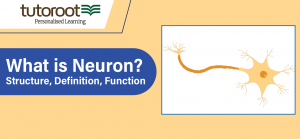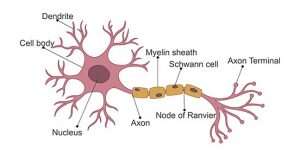What is Neuron? – Structure, Definition, Function
Neurons play an important role in the transformation of signals from the brain to various important parts or organs across the body. If you want to learn more about these topics Additionally, we will also help you understand the structure of neurons, their applications, and their types in the below article. Apart from this neuron also performs various other important functions, which we will explain, briefly below. In this article, let us focus on the neuron structure, besides other key elements related to types of neurons and functions, getting a better understanding through neuron diagram.

What is a Neuron?
As stated in the above section, Neuron is defined as a specialized cell, which is generally used to transfer electric and chemical signals from the brain to various parts of the body. However, you must remember that there are multiple types of neurons in the human body, such as Motor and Sensory neurons. And based on their structure and type, they perform different functions.
Structure of a Neuron

From the above diagram, as you can observe there are multiple parts, inside the structure of neurons such as Dendrites, axons, synapses, Cell bodies, etc. Here in the below section, we will explain briefly each of their functions while understanding the structure of a neuron.
Cell Body – As you can guess from the name itself, the cell is the most important part of the neuron, as it consists of important components such as Mitochondria, Nucleus, Endoplasmic Reticulum, and Golgi Apparatus, etc.
The cell body is also called a soma and as explained forms the core component of the neuron. It contains the genetic data and ensures the maintenance of the structure of the neuron, besides generating energy to sustain the action.
Similar to any other cell body, the soma of a soma has a nucleus and specialized organelles and is enclosed by a membrane that protects as well as facilitates interaction with its neighbors.
Nucleus – As part of the structure of the neuron, nucleus forms the very important part of the neuron, as it performs various important functions such as storing DNA, facilitating transcription and replication of DNA, as well as maintaining cell integrity.
Axon – The tube-like structure at the end of the neuron as shown in the above picture is Axons, and its main function is to transfer signals between neurons.
Node of Ranvler – This component of neurons generally involves facilitating the rapid communications or passing of electrical and chemical signals between two neurons.
Dendrites – A branch-like structure, similar to the Axon, that helps in transferring signals between neurons.
Dendrites are the fibrous roots that branch out from the cell body and form a crucial part of the structure of any neuron. Reminding us of antennae, dendrites receive and process signals from the axons of other neurons. Neurons also feature having more than one set of dendrites and these are called dendritic trees. Again, this number is determined by their functions.
Oligodendrocyte – The process of insulation of sheath axons is only possible because of the component Oligodendrocyte, which is formed as an end product of the process of Cell Lineage.
Types of neurons
Based on structure, genetic aspects, and functions, types of neurons are innumerable. However, we can list our five major types of neurons:
- Multipolar neurons, the most common type possess a single axon and symmetrical dendrites extending from it.
- Unipolar neurons are generally seen in invertebrate species and have one axon.
- Bipolar neurons feature double extension from the cell body with the axon on one side and the dendrites on the other. We find these mostly in the retina of the eye and also in parts of the nervous system.
- Pyramidal neurons, the largest of neuron cells in the cortex, with one axon but many several dendrites, are pyramidical in shape. The cortex is a part of the brain that determines our conscious thoughts.
- Purkinje neurons with multiple dendrites stemming out of the cell body and are inhibitory neurons, denoting the release of neurotransmitters that keep other neurons from firing.
Types of neurons – Functional
Sensory neurons that determine
- taste
- smell
- hearing
- seeing
- feeling
Motor neurons (lower and upper) determine voluntary and involuntary movements and allow the brain and spinal cord to communicate with muscles, organs, and glands across the body.
Lower motor neurons carry signals from the spinal cord to the smooth muscles and skeletal muscles while the upper motor neurons carry signals between the brain and the spinal cord.
Interneurons or neural intermediaries are found inside the brain and the spinal cord. They pass signals from sensory neurons and other interneurons to motor neurons and other interneurons.
Functions of Neuron
Now that you have a good understanding of neuron structure, parts of neuron, through the above neuron diagram. Let us now talk in detail about the different functions of neurons. Here is the below section.
- The first function of neurons is to receive signals from the brain or various other parts of the body.
- And the next function involves deducting the importance of the signal, to decide whether it needs to be sent to the next neuron or not.
- And if the information is important, the neurons will decide and send the signal toward the correct cell or body.
How do Neurons work?
Neurons pass signals using action potential that denotes a shift in the neuron’s potential electric energy caused by charged particles’ flow. This flow happens to and from the neuron’s membrane. Whenever an action potential happens, it’s transmitted along the axon to a presynaptic ending. These synapses are the spots where neurons can send electrical and chemical messages between them.
There are both chemical and electrical synapses that can be triggered by the action potential.
Chemical synapses are those where a neuron releases chemical messengers called neurotransmitters. These travel beyond the synaptic cleft and bind to receptors in the postsynaptic ending of a dendrite.
In the case of electrical synapses, they form when two neurons are connected by a gap junction.
Conclusion
The above article provided a comprehensive description of neuron structure, parts of neurons, neuron diagrams, etc. And as you already know, Biology is a complex subject with a vast syllabus. Therefore, students find it difficult to cover all the topics on their own. This is why, it would be a good idea for these people to join the Online Interactive Classes offered by the Tutoroot platform, as they come with various benefits including cost-effective pricing.
FAQs
What does a neuron look like
A cell that is in the shape of a star, with a tail
What are the 3 types of neurons?
Functional, motor, and interneurons
What is the structure of a neuron?
- Cell Body
- Nucleus
- Axon
- Node of Ranvler
- Dendrites
- Oligodendrocyte
